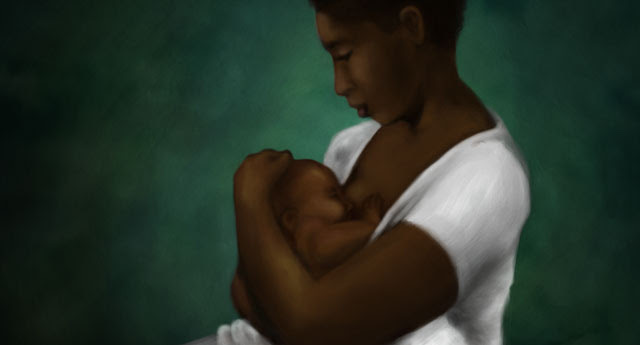By Eisa Nefertari Ulen

The movement to normalize breastfeeding in this country has generated positive results, but a racial gap in breastfeeding rates persists. According to the Centers for Disease Control and Prevention (CDC), 79 percent of all newborn infants in the US started out breastfeeding in 2011. That is good news for both babies and mothers, as breastfeeding yields significant health benefits, such as a lower risk of asthma and childhood leukemia for children, and a lower risk of gynecological cancers and osteoporosis for mothers. But the data suggest that US mothers require more support in order to continue breastfeeding. Among US-born children in 2011, only 49 percent were still breastfeeding at six months; and at 12 months, only 27 percent of those babies were still breastfeeding. For Black mothers and their babies, support needs are greater, as Black women’s rates of breastfeeding initiation and duration are significantly lower than the US average.
Only 58.9 percent of Black women initiate breastfeeding, while 75.2 percent of white women and 80 percent of Latina women initiate breastfeeding. A CDC report looking at babies born from 2000 to 2008 found that “Black infants consistently had the lowest rates of breastfeeding initiation and duration across all study years. Black mothers may need more, targeted support to start and continue breastfeeding.”
In order to increase breastfeeding rates, and the health benefits that derive from breastfeeding, African American mothers require systemic change to accomplish three essential tasks: erode the racial disparities in hospitals where babies are born, reduce the hyper-aggressive marketing efforts of corporations that produce formula, and curtail the violence of poverty that denies Black women the adequate maternity leave policies they need to breastfeed and the workplace conditions they need to pump.
Key Health Benefits
The World Health Organization (WHO) recommends that women who are able to do so breastfeed for at least the first two years of life. Even the American Academy of Pediatrics (AAP) recommends that women breastfeed beyond that organization’s 12 month minimum guideline “for as long as mutually desired by mother and baby.” Breastfed babies have lower risk of eczema, ear infections, SIDS, Type 2 diabetes, diarrhea and vomiting, and lower respiratory infections, in addition to lower risk of asthma, obesity and childhood leukemia. Breastfeeding also has positive effects on cognitive development that increase with longer breastfeeding durations.
With all these health benefits, it’s crucial that African American infants derive the power of breast milk from their mothers. According to the US Department of Health and Human Services (HHS) Office of Minority Health, Black infants have 2.2 times the mortality rate as white infants and are 3.5 times as likely to die as infants due to complications related to low birth weight. Author and breastfeeding advocate Kimberly Seals Allers, the project director of the First Food Friendly Community Initiative, insists that the normalization of breastfeeding in the Black community is a matter of life and death. “Breastfeeding in the Black community is particularly important because of our high infant mortality rates,” she says. “Our babies are disproportionately born too small, too sick or too soon — these babies need breast milk the most to stay alive! We often think of breastfeeding in this country as a choice/lifestyle issue, but in our community, where even college-educated Black women are more likely to have a low birth or preterm birth, breast milk, with its preventive health benefits and immunological properties, is crucial.”
The power of breastfeeding is also crucial to the health of Black mothers. The National Cancer Institute reports that white women are more likely to get breast cancer, but Black women are more likely to die from the disease. Black women also have higher rates of cervical cancer and the highest death rate from this disease. A 2013 study published in Gynecologic Oncology found that white women “have a higher incidence of ovarian cancer compared to Black women. However, the all-cause ovarian cancer mortality in Black women is 1.3 times higher.” And a 2009 article published by the National Institutes of Health (NIH) concluded that “Black women with endometrial cancer have a poorer prognosis compared with white women.” Breastfeeding also reduces the mother’s risk of gynecological cancers, including ovarian cancer and uterine cancer, as well as breast cancer and osteoporosis.
Breast milk is also a contributor to greater financial health (a significant bonus given that Black women earn 77 cents for every dollar earned by white women) and to the health of the planet (an important issue in communities of color where the experience of environmental injustice presents additional health consequences). This perfect food is always the right temperature, is free and reduces mothers’ carbon footprint because there is no formula packaging to dispose of.
Babies and mothers who miss the opportunity to benefit from breast milk often live in what Allers calls “first food deserts“: areas where the majority of employers do not have a breastfeeding policy, where the local child care facilities have not been trained to properly handle breast milk and where public places like museums and shopping malls do not have nursing rooms. These areas also lack breastfeeding support groups and the majority of residents polled in them say they would be uncomfortable seeing a woman breastfeed. In first food deserts, the nearest hospitals have generally not been designated “Baby-Friendly,” and statistics confirm that local doctors do not provide lactation referrals.
Allers says, “Just as we understand there are areas in the US where people can’t easily access healthy food, there are areas of the country where there are literal deserts of support, resources and sentiment for mothers to successfully feed their infants their healthiest food. Most of these communities are primarily Black and brown. My work as director of the First Food Friendly Community Initiative is all about creating a nationally replicable model to turn these vulnerable communities into more supportive environments. But there are inequities of support that need to be addressed.”
Breastfeeding and Black Women: A Painful History
Although the barriers to breastfeeding initiation and duration are contemporary issues — but they are rooted in and complicated by histories of enslavement.
“We can’t discount the fact that during slavery Black women were stopped from breastfeeding their own children to breastfeed the slave master’s children,” Allers says. “Historical records show that many slave children died because their mothers could not breastfeed them enough. Because of this, there is sometimes a negative association with breastfeeding, especially among older relatives, as something we were forced to do, something we did for others and not for ourselves, or something associated with a negative part of our history.”
Images of African American women caring for white children populate the American cultural landscape in everything from film and television to advertising and sales. Popular contemporary images of Black nannies holding white children that regurgitate the Aunt Jemima trope erase the children and other family members that Black woman were forced to leave every day for no pay (during slavery) or for barely enough pay (a dynamic that continues even today). This erasure of living, real Black children empties the American imagination, influencing even those health care professionals who work in Black communities. Their implicit bias perpetuates stereotypes that have real health consequences.
“Another issue is the negative stereotype that Black women don’t breastfeed,” Allers explains. “As a result, many health professionals don’t give important information [about breastfeeding] to Black women.”
Little to nothing in US culture popularizes images of Black breastfeeding women in a positive, affirming way, and so stereotypes persist.
This influence of popular culture on African American breastfeeding awareness is significant. Rebecca Jackson-Artis — an actor, writer, comedian, lactation specialist and doula who coordinates a program within the V.O.I.C.E. Therapeutic Solutions PLLC mental health agency in Raleigh, North Carolina, which focuses on assisting underserved women during pregnancy, birth and postpartum — says: “Media is powerful, and when we continuously hear about what we are not doing, it is like a goal vacuum. It sucks at our willingness to understand lactation and make it a part of our motherhood journey.”
The images of Black women caring for white children are not counter-balanced by images of Black breastfeeding women caring for their own children, even in pamphlets and other materials meant to encourage breastfeeding. “There are little to no postpartum resources for African American mothers in their communities, and if an African American mom lives in a high resource community she doesn’t see herself in the information provided,” Jackson-Artis says. “The power of seeing yourself in the solution is imperative.”
Allers points to white celebrities like Angelina Jolie, Jennifer Garner, Gwen Stefani and Alyssa Milano who have worked to promote breastfeeding in the mainstream and says, “Black women really haven’t had as many mainstream role models.” Moreover, in popular culture, Black women’s bodies are often presented as sex symbols rather than as the bodies of maternal caretakers of their own children.
The legacy of slavery contributes not only to the dangerous idea that breastfeeding is a white woman’s experience, but also contributes to the hyper-sexualization of Black mothers who do breastfeed. Allers, who founded Black Breastfeeding 360, a multimedia content library on the Black breastfeeding experience, says that this “hyper-sexualization of Black women’s bodies also makes the body politics of breastfeeding especially unique for Black women.”
With a history of public shaming and the forced exposure of Black women’s bodies for public auction, it is no wonder African American mothers receive less support when they voluntarily expose their breasts to nurse.
Targeting Black Mothers: The Role of the Formula Industry
Meanwhile, formula manufacturers are pushing to fill each Black mother’s hand with a plastic bottle even before she attempts to cup her own breast to feed her child.
Allers identifies the US government as the number one purchaser of infant formula in this country. She adds that while the Women, Infants and Children (WIC) program — a government-run supplemental food program that provides federal money to states to serve low-income pregnant and post-partum women and their children up to age five with health referrals, nutrition education and food — has improved breastfeeding support, its offer of a free supply of formula implies that formula is the best alternative.
Obviously the gift of free formula can be a literal lifesaver for an infant whose mother is unable to breastfeed for medical reasons. For mothers who could breastfeed but don’t know the value of breast milk, however, or for mothers who simply need support to learn how to breastfeed, opportunities for optimal health are denied when the distribution of formula becomes routine. In these cases, infant formula functions as more than just a free giveaway to the underserved.
Allers has conducted cultural competency in breastfeeding training with hospital staff and reports that “there are a lot of negative perceptions of Black women and many have assumed we won’t [breastfeed] so they don’t bother to encourage and inform.” She adds that hospital administrators allow infant formula representatives to host events and provide meals for nurses, thus influencing the recommendations parents receive about infant feeding.
Nurses likely believe they are simply sharing the bounty when they hand out free goody bags containing formula at the hospital, but these goody bags undermine breastfeeding, as “women are told that their milk may fail and the formula is there ‘just in case’,” Allers says. Despite the research, the relationship between hospitals and formula companies endures. “Infant formula companies have been insidious in making multimillion dollar deals with hospitals to market free samples to mothers when they are discharged,” Allers adds.
Simone Toomer, an independent contractor for the Brooklyn Health Department’s By My Side Doula support program and a certified lactation counselor for their breastfeeding hotline insists, “No hospital or medical office should give out formula unless requested, as per the World Health Organization (WHO), however, it happens all the time. Families are being sent home with ready-made Similac bottles, not fully understanding that milk production is supply and demand.” Toomer explains that mothers have to breastfeed or pump to maintain their milk supply and having formula “sitting right there on the counter” at home increases the chance that a new mother will use it and her own supply of breast milk will be compromised as a result. “Unless medically indicated, everyone should have a fair shot at nursing and seeking support if needed,” she says.
When a hospital sends new parents home with a free diaper bag stuffed with formula and a batch of coupons to buy more, the implication is clear: the hospital knows best, and the hospital endorses the use of formula.
From Workplaces to Hospitals, a Lack of Systemic Support
For Black mothers who are also working women, the barriers to greater breastfeeding duration are even higher.
According to a 2007 fact sheet published by the Institute for Women’s Policy Research (IWPR), of the 100 most family-friendly employers in this country, 24 percent provide four weeks or less paid maternity leave and 52 percent provide six weeks or less. Twenty-eight percent of the best companies do provide nine or more weeks of paid maternity leave, but seven percent offer only one-to-two weeks and another seven percent offer no maternity leave at all.
“In this country, we have no federal maternal leave,” Allers says. “Many mothers are returning to work two-to-three weeks after breastfeeding and they may not have the job security to advocate and navigate pumping at work. With these structural barriers, breastfeeding for any meaningful duration has become a privilege — the privilege of women who can stay at home/work from home, a privilege for women at progressive companies who have added paid maternity leave or with an office to easily pump.”
In her work as a postpartum doula and lactation counselor with an independent practice, Toomer has witnessed all these impediments to breastfeeding firsthand. “When we look at Brooklyn, La Leche League groups stop at Bed-Stuy [a community experiencing gentrification] and nothing goes towards East New York, Canarsie and Brownsville [neighborhoods that are overwhelmingly African American],” she says. “I mention to clients to check insurance coverage of lactation support and many have no idea of this. When you have someone who needs to go back to school or work because circumstance doesn’t allow extended maternity leave, we see nursing interrupted.”
These disparities in access to breastfeeding support begin even before new mothers leave the hospital where they delivered.
A 2011 CDC report identified multiple ways in which traditional hospitals privilege white women in their provision of breastfeeding support. Jackson-Artis has seen this racial disparity in traditional hospitals, even excellent traditional hospitals, firsthand. “I was a breastfeeding peer counselor in a very progressive hospital and I saw repeatedly how Black women and Brown women were treated in regards to postpartum care and lactation support,” she says. “There is an assumption we are going to formula feed and be negative about breastfeeding. We are either feared or ignored. So, we receive subpar support. I even had a white pediatrician say to me, ‘Black women aren’t receptive to breastfeeding help.’ Need I say more?”
Statistics suggest that this blaming of the victim is less likely to take place in hospitals that go through the rigorous process to be designated Baby-Friendly, a UNICEF/WHO initiative that rewards birthing centers, including hospitals, that support breastfeeding. An abstract published in the Journal of Human Lactation in May 2007 said that, “Breastfeeding duration is traditionally poor in low-income, Black populations in the United States. Among a predominantly low-income and Black population giving birth at a US Baby-Friendly hospital, breastfeeding rates at 6 months were comparable to the overall US population.”
Of course, Black women cannot wait for more hospitals to do the hard work required to become Baby-Friendly. We continue to be our own best advocates for better health through breastfeeding. Allers is the founder of Black Breastfeeding Week, a celebration of Black motherhood she established “to create an awareness week during Breastfeeding Awareness Month in August to just focus on showing breastfeeding as important in our community.” At the annual Twitter party celebrating Black Breastfeeding Week, Allers says there were nine million impressions.
These online celebrations of Black breastfeeding begin to generate a different narrative for African American mothers, one that celebrates breastfeeding within a community that has endured centuries of stigma and struggle. And on-the-ground changes are apparent too.
“Brooklyn is a hot spot right now [for breastfeeding awareness within Black communities],” Toomer said, “and I think, as we are becoming aware and awake, we will continue to see change. Knowledge is being passed along and our communities are becoming empowered slowly but surely.”
In her work, Toomer also sees more women of color becoming lactation counselors and consultants and certifying bodies like Doula Trainings International are making this profession more accessible by offering scholarships specifically earmarked for women of color. Toomer adds that raising awareness of the racial disparities in breastfeeding rates is key. “We are becoming more transparent in the reality of these disparities, what to expect and how to overcome,” Toomer says. “We are shifting.”
Jackson-Artis, who held a board position in Breastfeed Chicago for five years, says:
Many of us are actively changing the world with our work. Kimberly Durdin and Sherry Payne are making sure there are IBCLCs [International Board Certified Lactation Consultants] of color throughout the US. They are accepting donations to make sure African American women can afford lactation education via scholarships and support. Kimberly Seals Allers is making sure our activism is in the media with her blog and lectures around the country. Tytina Sanders-Bey works hard every week to provide support groups and classes in the south side of Chicago. Leah Hayes educates and supports many African American mothers in Alabama. Afrykayn Moon Aku is finishing her powerful documentary about the history of Black women in breastfeeding. Moon has had podcasts and a YouTube channel getting the word out about our vital role in the success of African American women breastfeeding.
These are just some of the African American women working to improve maternal and infant health through breastfeeding advocacy. This advocacy insists on the powerful best that comes from our own bodies. “Breastfeeding is empowering in a world that doesn’t always value our children,” Allers says. “When we breastfeed,” she adds, “we show that we do.”
Eisa Nefertari Ulen is author of the novel Crystelle Mourning, a novel described by The Washington Post as “a call for healing in the African-American community from generations of hurt and neglect.” She is the recipient of a Frederick Douglass Creative Arts Center Fellowship for Young African American Fiction Writers, a Provincetown Fine Arts Work Center Fellowship and a National Association of Black Journalists Award.
Preview YouTube video Place Matters: What is a First Food Desert?















